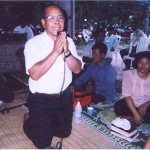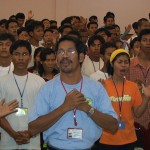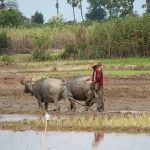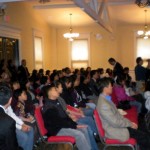September 1, 2009
Tong Neak: A Boy in the Killing Field, A Man in the Healing Fields
By Mr. Uon Seila, edited by Brian Maher
My name is Seila Uon and I was born on January 1, 1960. I was raised in a Buddhist farming family in Tong Neak Village, Baphnom District and Prey Veng Province in the Kingdom of Cambodia. I am the oldest in my family and I have five siblings. My village was very primitive and there was no pre-school therefore I was enrolled to the primary school when I was 8 years old.
In March 18, 1970 Cambodia was thrown into a state of civil turmoil because our King, Norodom Sihanouk, was overthrown by his defense minister, Lon Nol, while he was out of the country. This coup de tat was organized and encouraged by the United States in order to ensure an official invitation for an American presence in Cambodia during the Vietnam War era. It was a short lived presence as the American Congress pulled all troops out of Cambodia by the end of 1971, with exception of a handful of military advisors. My school was closed during this time for a while because most of the teachers went to Phnom Penh for a mass demonstration in favor of the return of the King. Some teachers went into the forest to join with the movement of the Sihanoukists. Cambodia was at war and school became irregular at best. In other word it was off and on. In Cambodia during the early seventies, factions and armies fighting in Cambodia were, FANK (Lon Nol Republic), Khmer Rouge, Khmer Vietminh, US Armed Forces, North Vietnamese, Viet Cong and the South Vietnamese
In January 31, 1971 around 2:00 PM two American Aircrafts roared over my village, dropping 24 bombs. My house was blown up into the air. Hundreds of chickens, dozens of pigs and other livestock were killed. My family’s rice paddy became smoking craters and then ponds.
I wondered why the Americans did such a thing to my village? From that moment on I became a refugee, though I was only eleven years old. Moving from the province to the city was hard for refugee families like ours, especially for my father who had to support my schooling. So my father sent me to stay and learn with the Buddhist monks at the Botum Waddei pagoda. I felt hatred toward the Americans because I was separated from my parents, brothers and sisters, and especially my home village where it used to be peaceful and pleasant. As a village boy I used to tend the cattle and sit on the backs of cows and sing happily. Now I found myself as a city boy—a Khmeng Wat, (pagoda boy)—who had to wake up a 4:00 a.m. to sell bread along the streets in Phnom Penh. These streets were sometimes deserted and quiet because of sporadic Khmer Rouge shelling. I was fearful, but my business went well because people feared the shelling and so stayed home. They did not venture out to eat Koy Teo (noodle soup) in storefront restaurants, so they bought my bread instead as I walked the streets yelling, “Nompang, Nompang, Pang-Pang, Sreuy Lahawe, Kadow!”
Life grew harder and harder. I woke at 4:00 a.m. to sell bread and had to return by 7:30 a.m. to attend school. Sometimes my business did not go well. I was late for school and got punished by my teacher. The more I suffered in the city, the more I missed my country life—and the more I hated the war and the Americans. I was looking forward to Khmer Rouge coming and liberating this city that was rife with the corruption of the American-backed Lon Nol regime. My family became refugees in my own country. Even though I had a father and mother, I lived my life as an orphan refugee-street urchin.
At last, on April 17, 1975, around 9 o’ clock in the morning after intensive shelling and fighting from the two previous days, the Khmer Rouge invaded Phnom Penh. I heard the news in the radio in which Khmer Rouge broadcast saying that war is over but about the announcement did not seem quite right. They said the war was over and that they won not by negotiating but by the flowing of blood. It was both sweet and bitter. I was overjoyed that I could return to my home village and study in the school I used to attend, and I contemplated the hope of seeing all of my schoolmates there.
Before the Khmer Rouge invaded the city, they pounded it with artillery. At first, I was happy and looking forward to returning home. However, I lost my father in the artillery barrage. Hearing that he had been injured and suspecting that he had died, my mother turned back to look for him, leaving me in charge of my five siblings. At age 15, I was the oldest of six in our family, and so became I became the head of my family during the forced evacuation from Phnom Penh. I led my two sisters and three brothers on a trek from Phnom Penh to Kompong Trabek, Prey Veng Province. I heard nothing from my mother. One sibling cried for rice, another for water, and the smallest for breast milk, because when my mother left us she thought that it would only be for a short time. That is why she left my youngest brother with me. The evacuation from Phnom Penh was hard. I hated the Americans.
Finally we arrived at my childhood village. What I had looked forward to did not happen. The villagers labeled me a pro-American imperialistic betrayer of the village. Now it was like jumping from the frying pan into the fire. Life was excruciatingly hard under Khmer Rouge. We endured continual intimidation and verbal persecution. What I expect to be better living situation in my home village was even worse. In three years, eight months and twenty days under the Communist Khmer Rouge was brutal. The Khmer Rouge authorities that charged my family of escaping from my village to support the puppet government of American imperialists accused me. I was sent to the mobile camp where I was forced to work hard. There was no school for me to pursue my studies.
I slowly began to realize that the Americans had tried their best to save my country from the communists. I began to feel deep love for the USA. Every moment I thought about America. Deep down in my soul and my spirit, a kinship for Americans became rooted in my whole being. I longed to go there.
On January 7, 1979, the Vietnamese soldiers liberated Cambodia from the Communist Khmer Rouge. I hoped my country would be at peace but the war continued to rage along the border in the western part of the country. I was under yet another regime and I was asked to join the military, which was the last thing I wanted to do so I decided to escape to the Thai/Cambodia border camps hoping to be repatriated to the USA.
In 1981, I traveled to the Thai/Cambodian border to try to get to America. In the refugee camp people asked me if I would be willing to go to Australia, France, Canada, or some other country. I said, “No, the only one country I want to go to is America.” I ended up stuck in the camps in Thailand for 12 years, where I committed my life to following Christ as my Lord and Savior through YWAM’s (Youth With A Mission) ministry, and never got that chance to go to the United States.
In 1989 I decided to work with Campus Crusade for Christ as an evangelist team leader in Site 2, the biggest Camp in Thailand, where I was chosen to be a pastor of a church.
At last on March 10, 1993, I was repatriated to Cambodia and decided to stay in Phnom Penh ever since. I started working with YWAM again. I attended one of the churches in the city. I help the church as a translator for seminars, which are led by missionaries from Malaysia or Singapore. I served in the church as leader of the elder committee. I chose not return to my home village because I did not want to face the intimidation of 1975 all over again.
In October 1995, I was invited by Scripture Union to attend SU institutes and SU Camp. After returning from SU camp in Malaysia I start working as a council member for SU and was instrumental in calling together nationals and missionaries to organize Cambodia’s first National Youth camp under Cambodia Christian Service’s Youth Commission. I also pioneered the movement of teaching sexual awareness from a Biblical perspective to Christian Youth, encouraging them remain pure in the midst of a sexual revolution where many young people are dying of HIV/AIDS. Each year I led a workshop during youth camp about Boy and Girl Relationships. Using some of the material SU had given me, I wrote book on Sexual Awareness in the Khmer language and taught from this book in all the forums the EFC Youth Commission had such as Youth Camps, Sexual Awareness Seminars, Regional Youth Seminars and Provincial Youth Seminars.
In February 14, 1999, I was moved from YWAM to work as an Assistant to the Leadership Development Coordinator in Training of Timothies project in World Vision. I presently serve as the Director of the EFC Youth Commission of (Evangelical Fellowship of Cambodia). I am also a contributing member of the Committee of Children at Risk commission of EFC.
History of Tong Neak (2000) – Part One by Brian Maher
My long time friend and colleague, Mr. Uon Seila had been pestering me to go with him to visit the village of his birth. I don’t have a whole lot of free time so the idea of spending an entire day driving over roads full of pot holes did not appeal to me so much. But I agreed to go anyway. After all what are friends for?
So last Saturday we drove not all that far from the Vietnam border. We left Phnom Penh driving south to the city of Neak Luong which is in Prey Veng province. At Neak Luong we drove onto the ferry with about 40 other vehicles and crossed the Mekong River. We continued on another 20 kilometers along route one, where pot holes multiplied exponentially. At the town of Kompong Trebaek we left the paved road and followed a well maintained ox cart path deep into the country side, entering the bowels of some of Cambodia’s poorest areas. After leaving the ox cart path we drove on rice paddy dikes, crossed small streams, and cut through dry rice fields (don’t tell Harry I did this with his beloved truck). We kicked up some serious clouds of dust the whole way. We traveled off the improved road, perhaps 16 kilometers, finally arriving at the village of his birth, Tong Neak, which means “Flagpole of the Novite monk”. There is quite a story behind the story behind this name but that will have to wait. This place was really in the middle of nowhere and it took us all of five hours to get there. It was as if nothing had changed here for over two thousand years. No relief and development agencies at all were working in the immediate area.
After introducing me to his mother and aunties, Seila walked me around me his part of the village. He explained to me how when he was about 11 years old his section of the village was hit by two different air strikes in January of 1971, and later in that year. The village was then completely destroyed. His house was burned down to the ground. That day we counted 24 bomb craters. He said he remembered that day very clearly as some VC were passing through his village when a US Army spotter plane came in and fired a smoke round to mark the position of the VC which were only meters away from his house. He said two minutes later they heard the thundering of engines as jets came in from the east to deliver their pay loads. Then all hell broke loose around them as bombs blew a part trees, rice paddies, and structures, setting everything a flame. All the houses in his section of the village were burned to the ground. The bomb that fell on his house made such a deep crater that it drew water which they used for a couple of years until the water table dropped. Since there are no relief & development agencies working in the immediate area, he wanted me to see his land and the craters, hoping that somehow I could help-all the infrastructure had been destroyed. The place had never recovered from the bombing in early 1971. A second raid on VC cutting through that area later that year killed two fellow villagers and injured a woman holding her child who was decapitated in the bombing.
After the two bombings of his village, Seila and his four younger siblings and hitched a ride to Phnom Penh to seek refuge. When the Khmer Krahom (means red) took over in 1975, they were forced back to their birth place, Tong Neak. It took them what they were years to walk back, sleeping under trees on the side of road, but in reality, it was just over a month. Seila’s 2 year old brother died as soon as they arrived home. Mines were planted just a meter off the road.
Today his sixty year mother still lives there. Most of her children are grown and gone and she depends on some of the grand children and other relatives to get by. They have to walk about a kilometer to get water. They carry two buckets of water on opposite ends of a pole, balanced on their shoulders.
Seila is very much pro- American but he is kind of still waiting for some Americans to take responsibility and come to fix his village. He wants to write to the American Embassy or to Senator Dana Rohrbacher to ask for help. After all, he does have a point. What right did we have to blow up his village, burn down his house and destroy the infrastructure of his village? And the results of that bombing raid live on to this day. If you’re still with me thus far, then you might consider helping this village. The village of Tong Neak needs two wells drilled. This would alleviate much of the hardship as they would have clean drinking water and water to grow vegetables during the dry season.
The wells cost about $200 apiece. Wouldn’t that be a good project for a church, a Sunday school, or youth group to raise money for a couple wells? Well, you might say, ‘this is not really missionary activity.’ And I would say, ‘ it doesn’t much matter what we call it, the Bible commands us to minister to the poor and oppressed, and not just as a platform for evangelism. We are to minister to the poor regardless!
I did ask Seila if there was a Christian presence anywhere nearby. Seila said no. He said he had told his mother and aunts about Jesus on a couple of his visits but they were unable to comprehend the message. He explained me that it would be difficult for some one from the outside to come in have much success, as they would tend not to trust outsiders. This is why drilling a couple of wells would be a great project. First, it would meet their physical needs. Second, it would give us Christians an opportunity to respond biblically to people in need. Third, by doing what we should be doing with the poor, those being helped will wonder who wants to help and why? Then there would be a natural context for sharing the reason for the hope that is within us – Jesus Christ. By helping dig wells in this village, the people can experience the gospel rather than just hear the words. Jesus announced that with his arrival into this world, he brought the Kingdom with Him. And people who had contact with Him experienced some of what the Kingdom of God was like. This is our mission, too. Christians are to be agents of transformation, working alongside Jesus (Col 1:19) as He reconciles all things to Himself, whether it be souls, systems or infrastructures.
And speaking of stories of redemption and reconciliation….not to far from his village was where the Northern Zone, KR from Kompong Thom and North Central areas massacred the Khmer Rouge in the Eastern Zone (Khmer Krahom Bophaeh). In 1978, the cadre of the KR the Eastern Zone, who had some association with Vietnam, wanted to stop the killing of their fellow countrymen. During this time, Seila in his mid teens, was forced to crush stone in a quarry from early morning to late evening, seven days a week. One day he was searching for a tree trunk heavy laden with dew so he could soak it up with his Krama and quench his thirst. Walking back he stumbled on a semi-covered mass grave of the Eastern zone cadre who were killed by the Northern Zone KR. He fled not wanting to be discovered as one knowing about this carefully covered up massacre. He noticed trucks, each day, dumping more bodies into the graves. One of the Eastern Zone KR Commanders who himself had killed fellow countrymen was sick of it and was ready to flee to Vietnam when the purges began. Thousands of Eastern zone KR soldiers were killed.
TONG NEAK
LOCATION of PROJECT: Tong Neak Village, Sdao Kang, Prey Veng Province.
TYPE of PROJECT: Community Development with focus on children ages 3-5.
BACKGROUND and CONTEXT:
Historical Context:
Prepared by Mr.Uon Seila and Brian Maher
Around 1870 a village in Cambodia called Phum Dong Tong—the “Flagpole Village”—was ruled by a primitive warlord. People in those days believed in animism, ancestor spirits we call “Neak Ta,” and Buddhism. Some years harvests were poor because the rain was insufficient to grow rice. Villagers would then engage in a ceremony called Loeung Neak Ta to consult the spirits through a medium. Sometimes the medium said there was no rain because someone had had a sexual relationship outside of his or her marriage.
As part of a Cambodian wedding ceremony, people usually offer food to the spirits. If the people aren’t marrying but living together anyway, that means fewer wedding ceremonies—and consequently less food offered to the Neak Ta. Fearing reprisals from the spirit world, the ruling village chief at that time decreed that anyone found having sex outside of marriage must die.
One day a young man fell in love with a beautiful girl and they had an affair. Later he discovered that his lover was pregnant, and naturally grew frightened. So he devised a plan to escape the death sentence by entering the monkhood.
In Buddhist practice, when a man wants to become a monk he is given the title of Neak (or Naga, both of which mean “snake” or “dragon”). Such a person is a novice—in the early, untested stages of monkhood. When he is at last ready for the ceremony making him a full monk, he shaves his head and joins a procession with many people who come to witness his ordination. The “Neak” or novice monk usually rides on horseback, leading a long queue in the procession. This particular “Neak” was especially nervous. As he rode through the village he grew dizzy. So he dismounted and waded into a pond to wash his face, and promptly vomited into the pond! That pond was then named Trapaing Neak Ka-out—“Naga’s vomit pond”—a name it still bears today.
Then Neak remounted his horse and continued shuffling toward a Wat (or pagoda). The procession circled the temple thrice, and the ceremony began. The monks chanted for a time. Neak began to sweat profusely because he saw his lover arrive at the ceremony. After the chief monk finished chanting he ordered Neak to remove his lay clothes and slip into a saffron robe. Needless to say, his lover jumped and grasped him from behind, crying loudly. Everybody was astonished. The crowd quickly degenerated into a rioting mob. The village sergeant of arms led Neak away and killed him a few meters from the Wat. They cut off the Neak’s head and sent it to the village warlord, who then hoisted it up the flagpole. So after that the people named the village Tong Neak, “Neak flag,” understanding that his head on a flagpole would serve as a warning to generations to come.
The village of Tong Neak was also later called Tong Chey, which means “Victorious Flag.” The Khmer Rouge were proud of Tong Neak because during the Vietnam War the American Airforce bombed it on January 31, 1971, but not even a single Viet Cong was killed. However, during a second bombing later that year, a number of Viet Cong died, along with a few of my neighbors and their children.
I wondered why the Americans did such a thing to my village? From that moment on I became a refugee, though I was only eleven years old. Moving from the province to the city was hard for refugee families like ours, especially for my father who had to support my schooling. So my father sent me to stay and learn with the Buddhist monks at Botum Waddei pagoda. I felt hatred toward the Americans because I was separated from my parents, brothers and sisters, and especially my home village where it used to be peaceful and pleasant. As a village boy I used to tend the cattle and sit on the backs of cows and sing happily. Now I found myself as a city boy—a Khmeng Wat, (pagoda boy)—who had to wake up a 4:00 a.m. to sell bread along the streets in Phnom Penh. These were sometimes deserted and quiet because of sporadic Khmer Rouge shelling. I was fearful, but my business went well because people feared the shelling and so stayed home. They did not venture out to eat Koy Teo (noodle soup) in storefront restaurants, so they bought my bread instead as I walked the streets yelling, “Nompang, Nompang, Pang-Pang!”
Life grew harder and harder. I woke at 4:00 a.m. to sell bread and had to return by 7:30 to attend school. Sometimes my business did not go well. I was late for school and got punished by my teacher. The more I suffered in the city, the more I missed my country life—and the more I hated the war and the Americans. I was looking forward to Khmer Rouge’s coming and liberating this city that was rife with the corruption of the American-backed Lon Nol regime.
At last on April 17, 1975, the Khmer Rouge invaded Phnom Penh. It was both sweet and bitter. I was overjoyed that I could return to my home village and study in the school I used to attend, and I contemplated the hope of seeing all of my schoolmates there.
Before the Khmer Rouge invaded the city, they pounded it with shelling. At first I was nevertheless happy and looking forward to returning home. However, I lost my father to the artillery barrage. Hearing that he had been injured and suspecting that he had died, my mother turned back to look for him, leaving me in charge of my five siblings. At age 15, I was the oldest of six in our family, and so became its head during the forced evacuation from Phnom Penh. I led my two sisters and three brothers on a trek from Phnom Penh to Kompong Trabek, Prey Veng Province. I heard nothing from my mother. One sibling cried for rice, another for water, and the smallest for breast milk, because when my mother left us she thought that it would only be for a short time. That is why she left my youngest brother with me. The evacuation from Phnom Penh was hard. I hated the Americans.
Finally we arrived at my childhood village. What I had looked forward to did not happen. The villagers labeled me a pro-American imperialistic betrayer of the village. Now it was like jumping from the frying pan into the fire. Life was excruciatingly hard under Khmer Rouge. We endured continual intimidation and verbal persecution.
I slowly began to realize that the Americans had tried their best to save my country from the communists. I began to feel deep love for the USA. Every moment I thought about America. Deep down in my soul and my spirit, a kinship for Americans became rooted in my whole being. I longed to go there.
In 1981, I traveled to the Khmer-Thai border to try to get to America. In the refugee camp people asked me if I would go to Australia, France, Canada, or some other country. I said, “No, the only country I want to go to is AMERICA.” I ended up stuck in the camps for 12 years, and never got that chance to go to the United States.
At last on March 10, 1993, I was repatriated to Cambodia and decided to stay in Phnom Penh. I chose not return to my home village because I did not want to face the intimidation of 1975 all over again.
However, one day I did return to visit my mother. My village had stayed pretty much the same. Nothing had improved; rather things were worse. I invited an American missionary friend, Brian Maher to visit my home village to show him where the American aircraft bombed it. I told him I thought that Americans should make some restitution because they failed to save my country from the Khmer Rouge. They abandoned my country for reasons that I don’t understand. I showed him the craters dug out by the thousand-pound bombs, and he saw how poor the village really was. I think the man felt guilty because of what his country’s air force had done, or maybe the Holy Spirit convicted him. I think he wanted to make restitution and he said to me, “Let’s do something for your village.”
Background Information
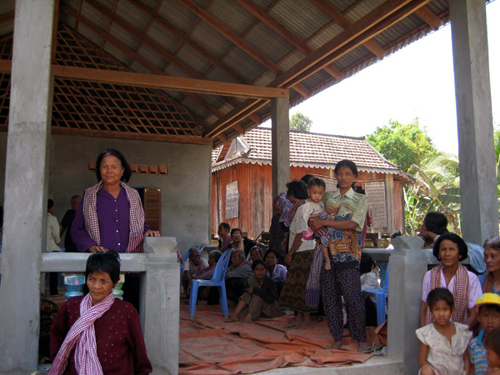
Community Center - Photo by Seila
Tong Neak is a small village in the remote area of Prey Veng province of the eastern of Cambodia. There are 186 families or 778 persons. The people in the village are farmers. In this most recent years the weather has changed drastically. There were floods and droughts three years in a row. The living situation of the villagers is very hard because of unusual changes in the weather.
I took my friend, Brian Maher who is an American missionary working in Cambodia doing youth ministry to visit Tong Neak in 1999. I explained to him how I survived during the war and how my village was bombed by the American aircraft. He felt pity on the villagers and he sent email to some of his friends and then they sent some money to help people in Tong Neak. We dug two wells and built two dams. The villagers are so happy about it. Especially this year, when there was yet another drought, the villagers could plant their rice in most of the rice fields near the dam which has held water from last year and this year’s rains.
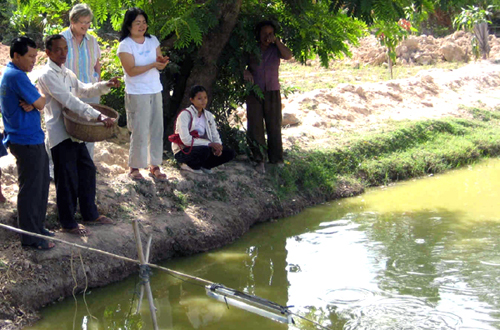
Photo by Seila
Past Accomplishments Since 2000
- Two wells dug
- Two dams
- One water filter (from Hagar)
- Emergency Rice Distribution 4x for the 774 families in Tong Neak Village.
- Seed Rice donated
- Thatched roof school building for pre-schooler (96 children)
- Added another room bringing children up to 150 children, taking children from another village.
- School Supplies: coloring books, crayons, pencils, erasers, book bags.
- Water Urn for fresh drinking water.
- Drinking cups.
- Distribution of Christmas Gifts for Children sponsored by Samaritan’s Purse 2x.
- Water reservoir dug for second season rice crop and sustenance farming.
- Irrigation Canals for rice crops
- New roof on pre-school
- Silo and Rice Bank for use between rice crops.
Next Phase: Building an Open Air Community Building Center to be used for Christian Worship Services, Buddhist services and events, and community meetings, schooling, informal educational opportunities for the village; health, sanitation, agricultural, etc.
PARTNERS/DONORS
- First Presbyterian Church Bellevue, USA
- Pearl City Baptist Church, Hawaii, USA
- International Christian Fellowship, Phnom Penh.
- Evangelical Lutheran Church, USA.
Before the school was built
On February 24th, 2002 Seila and Dr. Russell Bowers went to Tong Neak to visit the first dam. Seila’s uncle shared with him about need of the under five children in the village. They find it difficult to commute to school that is about three to four kilometers from their houses so he suggest that he gave the plot of land which belong to him for building a preschool for the small children in Tong Neak. Seila invested $200 for school project and the village help with bamboos and thatch roof so eight months later school building was erected.
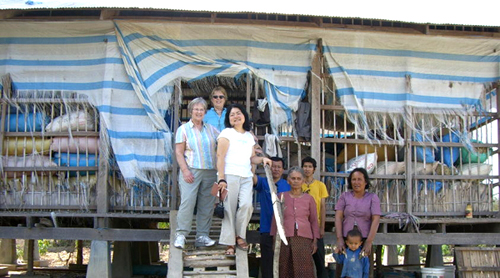
Provided by Various ministries
Goals:
- To provide basic sustenance and emergency relief to the oppressed and impoverished village of Tong Neak (which is situated in a geographical gap where the work of community development NGOs stops and starts) that suffers from both drought and floods which destroy rice crops almost every year.
- To help restore some of the vital parts of the infrastructure of the village in order to ensure safety for children and old people and to ensure that rice crops are protected and can be planted twice per year, thereby reducing dependence on emergency relief.
- Providing a pre-school service for children ages 3-5, giving children a basic foundation and a little head start before entering the government school. Children are exposed to Biblical material through use of Christian materials used in the school.
- To share the love of Christ to the villagers of Tong Neak by addressing first physical needs, then as they become attracted to Christ, share with them the Good News of the Kingdom when they are ready.
Written by: Cambodianchristian.Com
Trackback URL: http://www.cambodianchristian.com/article/wp-trackback.php?p=178
